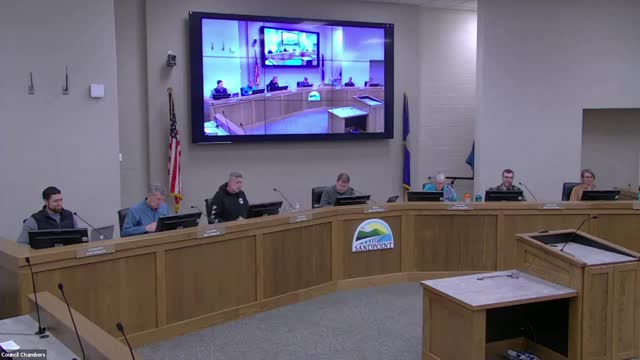Sandpoint High School Adeccah Club wins state competition with record score
March 22, 2025 | Sandpoint, Bonner County, Idaho
This article was created by AI summarizing key points discussed. AI makes mistakes, so for full details and context, please refer to the video of the full meeting. Please report any errors so we can fix them. Report an error »

During the recent City Council meeting in Sandpoint, significant discussions highlighted the community's growth, housing market trends, and ongoing legislative changes affecting local governance.
The meeting commenced with a commendation for the Sandpoint High School Adeccah Club, which achieved a remarkable score at the state competition, showcasing the talents of local youth. This recognition set a positive tone as the council turned its attention to demographic trends in the area. Recent census estimates indicated that Sandpoint's population has grown by 4.12% over the past four years, bringing the total to approximately 10,886 residents. This figure, however, falls below the anticipated growth rate of 2.5% outlined in the city's comprehensive plan, suggesting a more gradual increase than many residents may perceive.
In a related discussion, the council addressed the current housing market, noting that some multifamily units are experiencing vacancy rates as high as 15%. This trend could lead to a decrease in rental prices, which may benefit economic development efforts by making the area more attractive to potential employers.
The meeting also touched on legislative matters, particularly a new Senate bill that could limit local control over short-term rentals. The mayor expressed his intention to testify against this bill, emphasizing the importance of local governance in managing community issues.
Additionally, the council reviewed the progress of various committees, including the Arts, Historic, and Cultural Commission, which is working on initiatives such as a downtown walking tour brochure and public art projects. However, challenges remain, as committee members have reported frustrations regarding unclear directives and the allocation of staff resources.
The Pedestrian and Bicycle Advisory Committee discussed ongoing projects, including the Die Here subdivision and the downtown phase 3 project, indicating a proactive approach to urban planning and community engagement.
In conclusion, the meeting underscored the city's steady growth and the complexities of managing housing and legislative changes. As the council continues to navigate these challenges, the focus remains on fostering community involvement and ensuring that local voices are heard in the decision-making process. Future discussions will likely address the effectiveness of committees and the impact of state legislation on local governance.
The meeting commenced with a commendation for the Sandpoint High School Adeccah Club, which achieved a remarkable score at the state competition, showcasing the talents of local youth. This recognition set a positive tone as the council turned its attention to demographic trends in the area. Recent census estimates indicated that Sandpoint's population has grown by 4.12% over the past four years, bringing the total to approximately 10,886 residents. This figure, however, falls below the anticipated growth rate of 2.5% outlined in the city's comprehensive plan, suggesting a more gradual increase than many residents may perceive.
In a related discussion, the council addressed the current housing market, noting that some multifamily units are experiencing vacancy rates as high as 15%. This trend could lead to a decrease in rental prices, which may benefit economic development efforts by making the area more attractive to potential employers.
The meeting also touched on legislative matters, particularly a new Senate bill that could limit local control over short-term rentals. The mayor expressed his intention to testify against this bill, emphasizing the importance of local governance in managing community issues.
Additionally, the council reviewed the progress of various committees, including the Arts, Historic, and Cultural Commission, which is working on initiatives such as a downtown walking tour brochure and public art projects. However, challenges remain, as committee members have reported frustrations regarding unclear directives and the allocation of staff resources.
The Pedestrian and Bicycle Advisory Committee discussed ongoing projects, including the Die Here subdivision and the downtown phase 3 project, indicating a proactive approach to urban planning and community engagement.
In conclusion, the meeting underscored the city's steady growth and the complexities of managing housing and legislative changes. As the council continues to navigate these challenges, the focus remains on fostering community involvement and ensuring that local voices are heard in the decision-making process. Future discussions will likely address the effectiveness of committees and the impact of state legislation on local governance.
View full meeting
This article is based on a recent meeting—watch the full video and explore the complete transcript for deeper insights into the discussion.
View full meeting